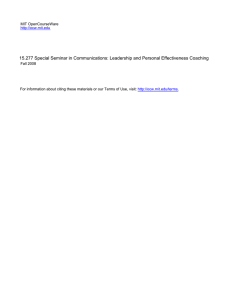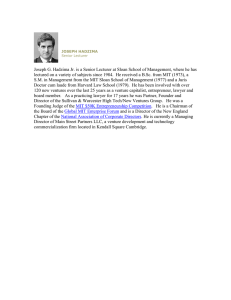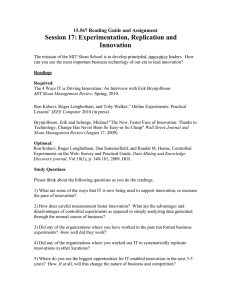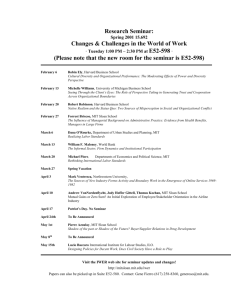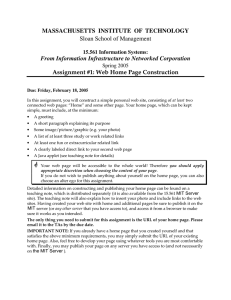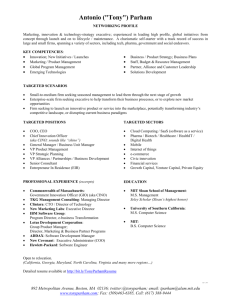15.992 S-Lab: Laboratory for Sustainable Business
advertisement
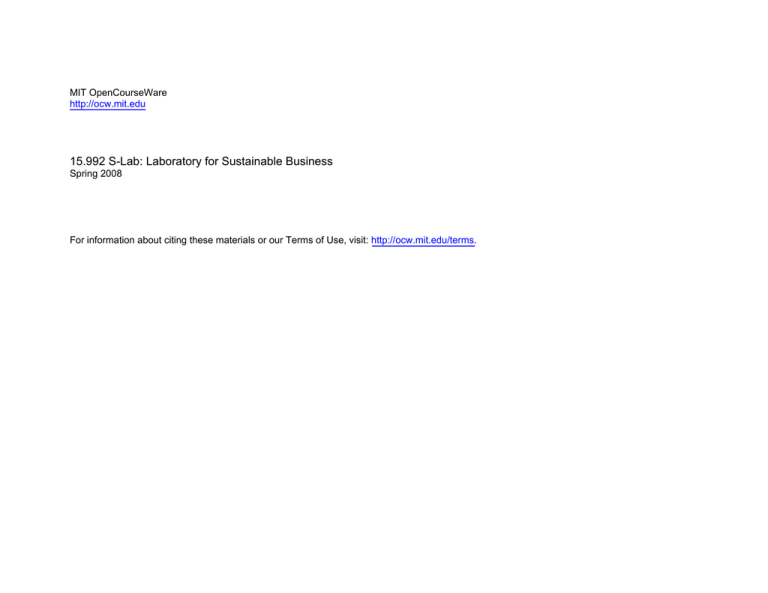
MIT OpenCourseWare
http://ocw.mit.edu
15.992 S-Lab: Laboratory for Sustainable Business
Spring 2008
For information about citing these materials or our Terms of Use, visit: http://ocw.mit.edu/terms.
Green Buildings – New
Services and Products
from Market
Transformation
Dr. Sarah Slaughter
S-Lab (15.992)
April 10, 2008
© 2005 MIT Sloan School of Management
Basic Statistics
• Construction expenditures ~$5 trillion per year
worldwide (New and Renovation/rehabilitation)
– US construction expenditures
• ~$1.1 trillion in 2007
• ~8% GDP (US Census, 2007)
– China construction expenditures
• ~$0.6 trillion in 2007
• ~7% of GDP (State Statistics Bureau)
• US building construction expenditures ~ 75% of total
– Residential ~ $450 mil in 2007
– Other building ~ $374 mil in 2007
© 2007 MIT Sloan School of Management
Sustainability and Buildings
“Buildings account for more than 40% of US energy use..[and]
produce 40% of atmospheric emissions…”
Resource Use
Share of
Total (%)
Pollution
Emissions
Share of
Total (%)
Raw Materials
30% Atmospheric
40%
Energy Use
42% Water effluents
20%
Water Use
25% Solid Waste
25%
Land
12% Other releases
13%
Source: National Research Council, “Green Schools:
Attributes for Health and Learning”, 2007.
© 2007 MIT Sloan School of Management
Sustainability and The Quality of
the Built Environment
“It is estimated that Americans spend more than 85% of
their time indoors…The quality of indoor environments
– levels of indoor contaminants {…}, temperature and
humidity, lighting, noise level, furniture and equipment
design – can influence a person’s health, comfort, and
ability to perform his or her job, to learn, to heal.”
Federal Facilities Council, “Implementing HealthProtective Features and Practices in Buildings”, 2005.
© 2007 MIT Sloan School of Management
Attributes of Green/Healthy
Buildings
• Sensitive to Natural Environment
• Effective with resources, including water, energy, and
material
• Contribution to community
• Durable and Dry (avoid accumulation of excessive
moisture)
• Comfortable, in air quality and temperature
• Quiet with improved acoustical quality
• Well-lit, with adequate natural and artificial light
• Well-maintained in surfaces and systems
Sources: National Research Council, “Green Schools: Attributes for Health
st
and Learning”, 2007; The Center for Health Design, “Designing
theMIT
21Sloan
© 2007
School of Management
Century Hospital”, 2006.
Expected Benefits From
Sustainable Buildings (USGBC)
Environmental benefits:
* Enhance and protect ecosystems and
biodiversity
* Improve air and water quality
* Reduce solid waste
* Conserve natural resources
Economic benefits:
* Reduce operating costs
* Enhance asset value and profits
Improve employee productivity and
satisfaction
* Optimize life-cycle economic
performance
Health and community benefits:
* Improve air, thermal, and acoustic
environments
* Enhance occupant comfort and health
* Minimize strain on local infrastructure
* Contribute to overall quality of life
© 2007 MIT Sloan School of Management
Examples of Benefits Accruing
From Sustainable Buildings
“Good landscaping aesthetics and large shade trees add an
average of 7% to rental rates.” (FiBRE, “Financing and valuing
sustainable property,” 2007)
• Over 50% cost savings (per s.f.) from reductions in O&M costs for
waste removal, cleaning supplies and labor, electricity, air filters,
water, landscaping (Sheehy, “Lessons Learned: Costs and
Benefits of High Performance Buildings”, 2006, p. 95)
• “Performance of simulated office work was increased 6-9% by the
removal of common indoor sources of air pollution […] while
increasing the clean air ventilation rate.” (NRC, “Green Schools,”
2007, p. 64.)
• 14-17% ROI from energy use reductions, and 5-17% from water,
sewer and stormwater reduction on new university building at
Portland State University (Gregory, “Lessons Learned: Costs and
Benefits of High Performance Buildings”, 2006, p. 111)
•
© 2007 MIT Sloan School of Management
Trends in Green Buildings
•~2% of all Buildings are “Green” (USGBC, McGraw-Hill, 2006)
•Expected: 82% of US corporations will green at least 16% of their
building portfolios by 2009 (McGraw-Hill, 2007)
•Growth in City Government Green Programs
Percent of Population (Cities) with Green Building Programs
TOTAL
Eastern
Population
Middle
#cities
Mountain
Western
0%
10%
20%
30%
40%
50%
Source: AIA, “Local Leaders in Sustainability”, Nov 2007
© 2007 MIT Sloan School of Management
Green Buildings – Rating Systems
• US Green Building
Council
(www.usgbc.org) LEED
(Leadership in Energy
and Environmental
Design)
– Types:
• New Buildings
• Existing Buildings
– Quantity
• Single Building
• Multiple Buildings
• UK BREEAM
(www.breeam.org)
• Australia Green Star
(www.gbcaus.org)
© 2007 MIT Sloan School of Management
Rate Your Home
(Based on LEED for Homes Pilot and Green Guide for Health Care 2.1 Pilot)
Certified: 30-49 Category
Silver:50-69
Gold: 70-89
Location and Linkages
Platinum: 90Sustainable Site
137
Immediate
Points
Improvement
Mid-term
Points
Improvement
14
7
7
Water Efficiency
12
1
10
Indoor Environmental Quality
24
1
1
Materials and Resources
25
10
3
Energy and Atmosphere
45
Homeowner Awareness
3
2
Innovation and Design
4
4
137
25
TOTAL
Maximum
Points
10
6
27
© 2007 MIT Sloan School of Management
Immediate and Mid-Term
Improvements in Your Home
© 2007 MIT Sloan School of Management
Value Chain for Buildings:
Green Transformation
Finance/
Insurance
Architect/
Engineer
Suppliers
Owner
Specialty
Contractors
Manufacturers
Program/
Construction
Manager
Government
© 2007 MIT Sloan School of Management
Value Chain for Buildings:
Green Transformation
Finance/
Insurance
Architect/
Engineer
Suppliers
Owner
Specialty
Contractors
Manufacturers
Program/
Construction
Manager
Government
© 2007 MIT Sloan School of Management
New Green Building Services
• Finance
– Green Building
Financing Services (e.g.
Bank of America)
– Green Building
Insurance Services (e.g.
Fireman’s Fund)
– Green REITs (e.g.
Revival Fund
Management)
© 2007 MIT Sloan School of Management
New Green Building Services
• Design
– Green Building Special
Design (e.g. Energy
Smiths)
– Green Building Modeling
(e.g. Whole Building
Design Guide – Tools,
http://www.wbdg.org/tool
s/tools.php)
© 2007 MIT Sloan School of Management
New Green Building Services
• Construction
– Green Construction
Management (e.g.,
CH2MHill)
– Waste Management (e.g.
Gypsum Recycling Internt’l)
– Commissioning (e.g.
Building Commissioning
Assoc)
© 2007 MIT Sloan School of Management
New Green Building Services
(cont’d)
• Operations
– Post-occupancy evaluations
– Occupancy sensors and controls (e.g. Aircuity)
– Energy Service Companies (ESCO) (e.g. Natl Assoc of
ESCO)
– Reliability-Centered Maintenance (e.g. Trane Corp)
– Remote Operations Monitoring and Control (e.g.
Johnson Controls and Gridlogix)
– Green cleaning (e.g. Seventh Generation)
– Integrated pest management
© 2007 MIT Sloan School of Management
New Sloan Building (E62)
Sustainable Design Elements
Expected to qualify for a “LEED Silver”
or higher rating.
• Lighting at an average energy use
below 1 watt per square foot (sq.ft.),
• Cooling at over 700 sq.ft. per ton,
• Heating at about 10 BTUH/sq.ft.,
• Control of heat gain by high
performance glazing supplemented
by motor-operated window shading
in critical application
• Occupancy sensing and demandbased ventilation
© 2007 MIT Sloan School of Management
New Sloan Building (E62)
Sustainable Design Elements
• Careful sizing of pumps and fans
to reduce parasitic loads.
• Operable windows
• Individual space temperature
control.
• Water-based terminal units like
chilled beams and radiant panels
• Partial “Green” roof
• Potential: Photovoltaic panels
• Diverted demolition and
construction waste
© 2007 MIT Sloan School of Management
New Green Building Product:
Green Roofs
– Soil layer with shallow root plants captures rainwater
and reduces runoff
– Lowers roof (and building) temperature, lowering
cooling loads
© 2007 MIT Sloan School of Management
New Green Building Product:
Chilled Beams
• Chilled tubes circulate cold
water
• As hot air rises, it hits the
tubes, cools, and falls
• Expected energy savings:
20-50%
• Potential cost reduction:
10%+ (compared to VAV)
• Higher air quality and
comfort
© 2007 MIT Sloan School of Management
New Green Building Product:
Building Integrated PV
• Translucent glass with PV
elements allows light into
building and generates
electricity
• 3.9 peak watts per square foot
(ASI Glass Solar Modules for
Building Integrated
Photovoltaics, Schott,
Elmsford, NY)
© 2007 MIT Sloan School of Management
New Green Building Product:
Permeable Paving
• Provide storm water absorption into groundwater
• Reduces storm water runoff
• Can be made with recycled materials (asphalt,
concrete, plastic)
© 2007 MIT Sloan School of Management
New Green Building Product:
Bamboo Flooring
– Rapidly renewable
– Nontoxic in
fabrication
– Easily cleaned
– Durable
© 2007 MIT Sloan School of Management
New Green Building Product: Grey
Water Capture and Re-Use
• Captures gray water from
showers, sinks, washing
machines, and cleans it for
re-use for toilets or
landscape
• Reduces water use by 3540%
© 2007 MIT Sloan School of Management
New Green Building Product:
Aerated Concrete Blocks
• Autoclaved aerated concrete
blocks
• Uses sterile mine tailings
• High insulative value
• Easy to stack
© 2007 MIT Sloan School of Management
New Green Building Product:
Moisture and Insulative Wrap
• Lightweight structural
sheathing panels
• 100% recycled cardboard
and aluminum-foil facings.
• Pressure-laminated with a
special water-resistant,
nontoxic adhesive.
© 2007 MIT Sloan School of Management
Steps to Improve Built Environment
• Inventory building(s) in resource use (e.g., energy,
water, solid waste), performance, and condition
(deterioration, change in use)
• Reduce => Eliminate waste
• Increase resource use efficiency
• Replace resource use where possible
• Upgrade to enhance attributes of healthy buildings
• Monitor performance
• Continually upgrade operations and building(s) to
meet objectives
© 2007 MIT Sloan School of Management
Resources
•
•
•
•
•
•
•
Building Green (www.buildinggreen.com, available thru MIT Libraries)
National Research Council, “Green Schools: Attributes for Health and
Learning,” National Academies Press, 2007.
Federal Facilities Council, “Implementing Health-Protective Features and
Practices in Buildings,” National Academies Press, 2005.
The Center for Health Design, “Designing the 21st Century Hospital:
Environmental Leadership for Healthier Patients and Facilities,” Center
for Health Design, 2006.
Andrea Putman and Michael Philips, “The Business Case for Renewable
Energy: A Guide for Colleges and Universities,” APPA, 2006
Earth Day New York, “Lessons Learned: The Costs and Benefits of High
Performance Buildings,” Earth Day New York, 2006
McGraw-Hill, “Education: Green Building Smart Market Report,” McGrawHill, 2007.
© 2007 MIT Sloan School of Management
